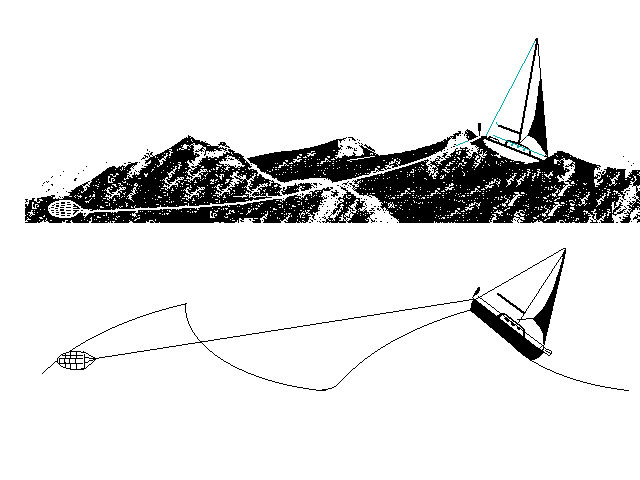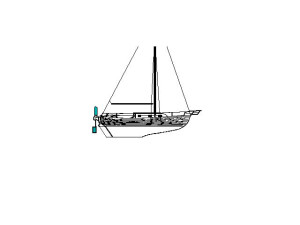Monohull, Nor'Sea 27
31' x 5 Tons, Full Keel & Cutaway Forefoot
30" Dia. Galerider Drogue
Force 10-11 Conditions
File D/M-7, obtained from George R. Purifoy, Pittsburgh, PA. - Vessel name Synthesis, hailing port Pittsburgh, monohull, Nor'Sea 27 (center cockpit version) designed by Lyle Hess, LOA 31' x LWL 27' x Beam 8' x Draft 3' 9" x 5 Tons - Full keel & cutaway forefoot - Drogue: 30" Galerider on 150' x 5/8" nylon three strand rode, with 1/2" stainless steel swivel - Deployed in a storm in deep water about 500 miles east of Block Island, New York, with winds of 50-60 knots and seas of 20-25 ft. - Vessel's stern yawed 20° with the owner steering manually - Downwind speed was reduced to about 3 knots in 15 hours of deployment.
George R. Purifoy, Jr., is a Pittsburgh engineer who completed a solo Atlantic crossing and return on board Synthesis, a Nor'Sea 27 - solid little world cruiser designed by Lyle Hess. The Nor'Sea 27 boasts of about 150 Atlantic and Pacific crossings, and 4 circumnavigations. Synthesis left City Island, New York, bound for the Azores and ran into an Atlantic storm on 12 June 88, approximately 500 miles east of Block Island. In an article appearing in the 32nd issue of Ocean Navigator, Purifoy recounted his trials and tribulations as he struggled to keep the sea in face of a mounting storm. Methodically, he went through the incremental steps of sail reduction - down to storm jib and double-reefed main. By the time it was blowing 40 knots it was dark and even the double-reefed main had to come down. Down it came, an inch at a time, "thrashing like a thing alive," the decks awash and illuminated by flashes of lightning.
As the storm built, Purifoy put Synthesis on a downwind course and began steering her in earnest. From then on it was a battle to keep the yacht from getting a little sideways and tripping on her keel. The mental states experienced by Purifoy in that perilous night might easily be experienced by any sailor running into a storm. Excerpts from the article follow (reproduced by permission of Ocean Navigator):
Boy, talk about scared! I am just on the ragged edge of control. One of these times I'm going to make a mistake and that will be all she wrote. To compound things, the steepness of the waves and our speed down them is causing the bow to bury in the base of the wave ahead.... Little Synthesis is taking green water over the bow up to the mast. Now, along with the distinct probability of a broach, is the very real danger of pitchpoling. Time for the last line of defense: the storm drogue. If I can't slow the boat down we're going to buy the farm for sure!
When Purifoy finally deployed the Galerider, there was a dramatic transition from chaos to control. The drogue took hold, slowed the boat's speed down to a safe and sane 2-3 knots, and helped to reduce the tendency to bury the bow. The article continues:
What a wonderful feeling. No longer are we rushing crazily toward a cold swim. The boat has slowed down to about two knots or so, even on the steep downhill faces of the waves. Those monster waves are still rushing at us from astern, but Synthesis just lifts her stern and all the foam and tumbling water just moves by. Beautiful! I still have to steer, but not with the strain and concentration of before. All of a sudden the storm seems manageable, duck soup even.
In subsequent telephone conversations with Victor Shane, Purifoy added the following: A bridle was used, with arms of 14' each, made of 3/4" nylon three strand, the tether itself being 150' x 5/8" nylon three strand; the deployment took place in the Gulf Stream; the storm jib was flying for the duration of the time in which the drogue was deployed; the boat had to be steered manually without interruption, although happily the steering was much easier with the drogue in tow; without continuous manual input at the helm Synthesis might have broached and/or capsized; notwithstanding she might not have survived the storm intact without the assistance of the Galerider. In answer to your Shane's question about the positioning of the drogue Purifoy had this to say:
The 150' rode seemed about right for the wave system - the drogue was always one wave back of Synthesis, and on the back side as Synthesis was on the front side. I guess the wave length must have been more like 90-100'.

Love the Drag Device Database? Help us to keep it free for all mariners by making a tiny donation to cover our server and maintenance costs. Thank You!
